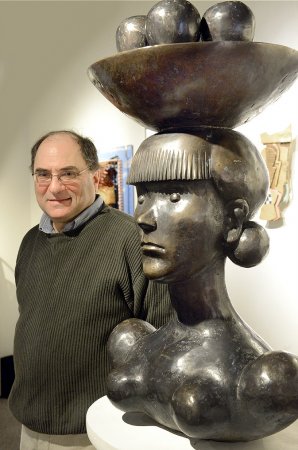Artist Statement
 Aub’s work shares affinities with the elegant sculptures of Elie Nadleman and the surreal paintings of Rene Magritte. Aub states, “I think of my work as a paradoxical marriage of clarity and enigma. As in dreams, content seems both rational and irrational. My work often deals with dualities, and the figure holds interest for me, in part, because of the “metaphor of the binary” imbedded in the natural bifurcation of the body. As in any work of art, the dynamic tension that binds the whole is sometimes created from a dissonance of the parts – and in these works, the implicit central line of division and organization, is emphasized by way of the symmetrical mirroring of the body parts and facial features along with the prosthetic treatment of the hairstyles, hats, and other external ornamentation. The conventional imagery suggested by the tradition of representation is offset by subtle forms of subversion such as the irregular orientation of the pieces. Regular and irregular are bound in unusual balances. If the sculptures have an air of silliness, there is also an undercurrent of seriousness as in the binary relationship of comedy and tragedy.”
Aub’s work shares affinities with the elegant sculptures of Elie Nadleman and the surreal paintings of Rene Magritte. Aub states, “I think of my work as a paradoxical marriage of clarity and enigma. As in dreams, content seems both rational and irrational. My work often deals with dualities, and the figure holds interest for me, in part, because of the “metaphor of the binary” imbedded in the natural bifurcation of the body. As in any work of art, the dynamic tension that binds the whole is sometimes created from a dissonance of the parts – and in these works, the implicit central line of division and organization, is emphasized by way of the symmetrical mirroring of the body parts and facial features along with the prosthetic treatment of the hairstyles, hats, and other external ornamentation. The conventional imagery suggested by the tradition of representation is offset by subtle forms of subversion such as the irregular orientation of the pieces. Regular and irregular are bound in unusual balances. If the sculptures have an air of silliness, there is also an undercurrent of seriousness as in the binary relationship of comedy and tragedy.”
Themes of circularity are present in the works in ways that are obvious and less so. Other than rounded forms, some of the pieces are designed to physically rock or roll in place, implying a circular movement for these otherwise static forms. Titles reflect circularity in their wordplay usage of palindromes, or, for example, in fragments of songs that imply endless circular musical loops. “Popular culture and folk art are references I enjoy and draw on for inspiration. In part, it is my intention to blur the distinction.
Additional Artist’s Statement:
An artist friend referred to my pieces as having “poetic symmetry,” and that old fashioned idea resonates with me. The balance found in the bodies’ opposite halves—when divided along the centerline—offers meaning in the form of metaphor referring to the binary opposites forming a coherent and harmonious whole. The body is a play of parallel doubles (eyes, ears, limbs) and singles (mouth, naval), and I find these variations endlessly interesting. The metaphor suggests opposites at play: the images portrayed are funny but serious.
The cartoony forms are reflected in the titles, sometimes using wordplay in the form of palindromes, i. e. ArOrA and eLLe. While Uomo Pannetone is not a palindromic title, it is humorous for different reasons. Translating to “man cake,” I should let that speak for itself, except to say Pannetone is a type of cake or bread of a similar shape that is popular in Italy at Christmas time. The compressed form of the mustachioed man’s head references the repressive politics found in fascist Italy under Mussolini, with its current American parallel. Perhaps that, too, is a form of duality that is present.
Dualities of body “parts” are very much present in the other two works, with ArOrA’s form branching off through the arms and fingers, for example. eLLe is caught in a cycle of surreal exercise where doubles are present in her dumbbells, high heels, and spindly limbs. Her implied crawling movement suggests an endless repetition of her two sides working together, but not in parallel sync.
All three pieces have either real or implied movement. Uomo Pannetone, for example, rocks gently forward and back just enough to test one’s comfort level. ArOrA was originally designed to roll side to side, but she is fixed in place for safety reasons. The contradiction of sculpture as a static medium is fully intended, but so is reverence to the great tradition of sculpture as solid objects that impart knowledge.
A.E. Ted Aub
